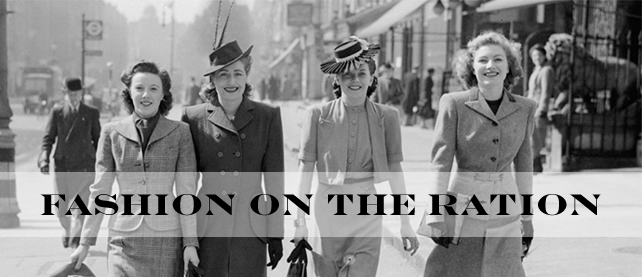
Just about every UK based vintage blog I have read lately has had a post about the Fashion on the Ration exhibition at the Imperial War Museum. I was actually lucky enough to be invited to the press opening but very annoyingly I couldn’t make it. Damn work and responsibilities. I do have plans to go and see it soon though but somehow I needed to get my own fix of wartime fashion right away.
So yesterday I took a trip up to the Oxfordshire Museum in Woodstock, a village on the outskirts of Blenheim Palace. The reason being because Julie Summers, who wrote the accompanying book to the exhibition, is doing a series of lectures in small museums around the country to promote it and this was the closet one to me.
When I set off I completely misjudged how long it was going to take me and I arrived 45 minutes early! Thankfully though, the museum was having its own fashion history exhibition called Keeping Up Appearances which covers the periods from the 1910s up to the 1950s and shows how the changing role of women had a direct impact on the style, material and cut of clothing. Although it was small, it was amazing and I wanted to grab everything and run off with it!
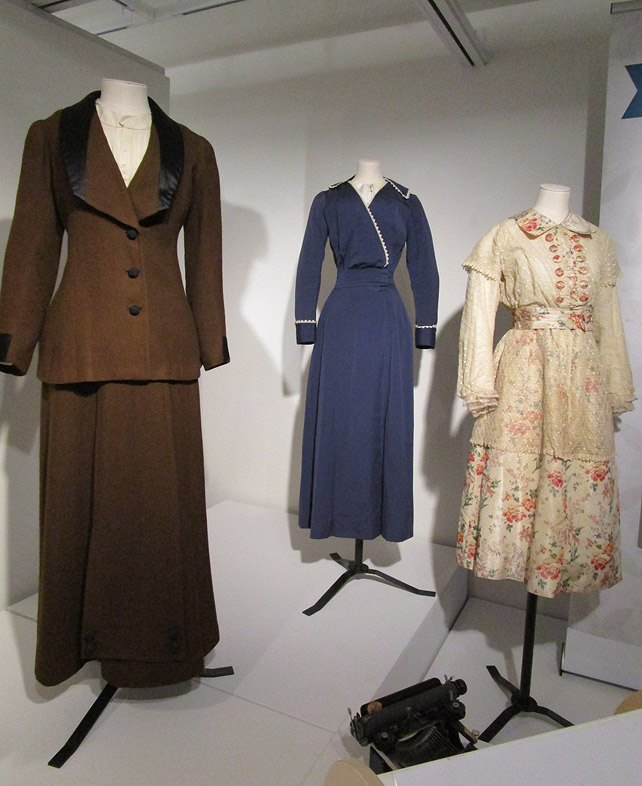
The first section showed how women’s roles began to change with some choosing to take employment as typists, teachers or nurses. This led to dresses becoming simpler and more streamlined so that women could move better in them.
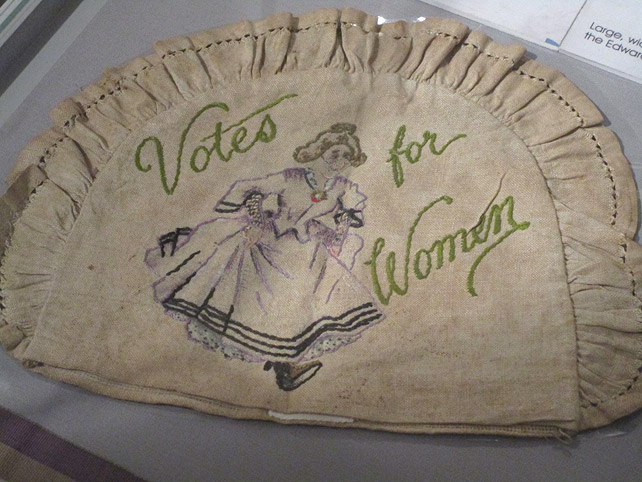
There was one cabinet that had several Suffragette pieces in it and my favourite had to be the hand embroidered Votes for Women tea cosy. The female character on it looks so old-fashioned to how we imagine the Suffragettes looking which makes me think this is from very early on in their campaign.
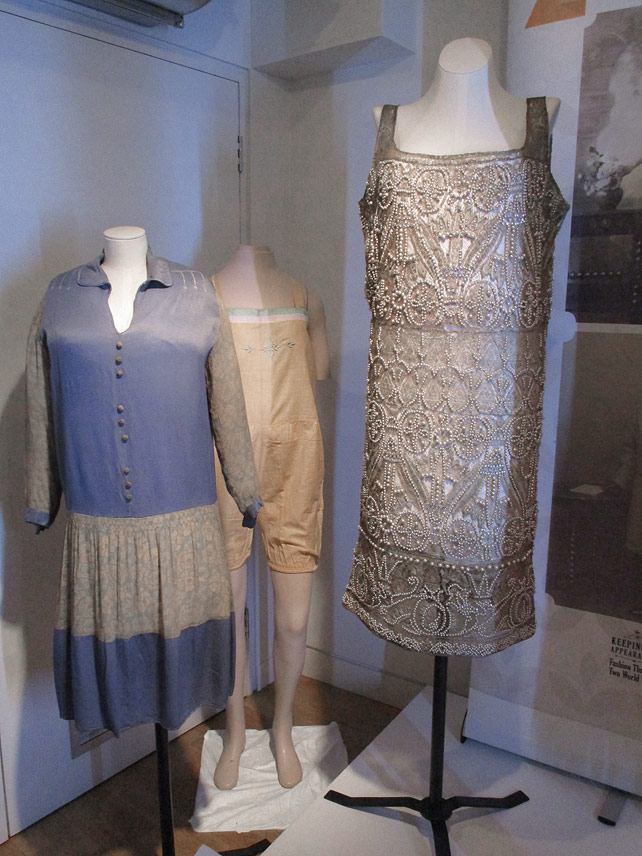
The Flapper dresses were just beautiful , especially this hand beaded, very column-like, piece. It looked immaculate as if it had just been bought from the shops yesterday. I loved the one-piece undergarment in the background. It was a beautiful peach silk, a much lovelier colour than in the photograph.
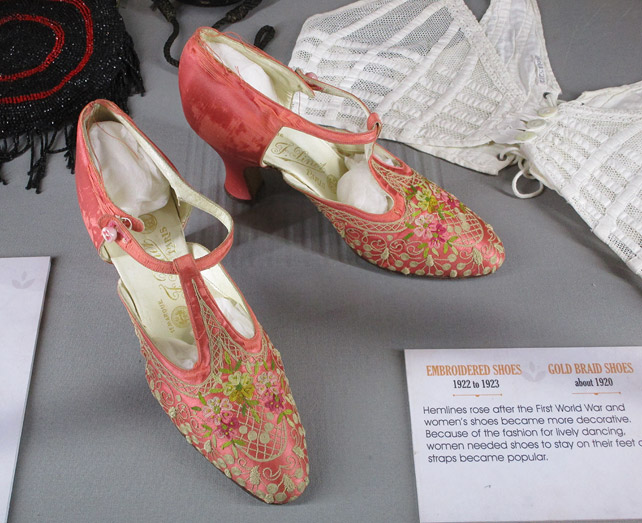
These pink silk shoes were just stunning. They were about a size 4 or 5 (my size!) but incredibly narrow. I have no idea how anyone would’ve got their feet into them and then danced all night. I loved the binding bra in the background that young women used to make their breasts appear flat and boyish. Not sure that would work on me!
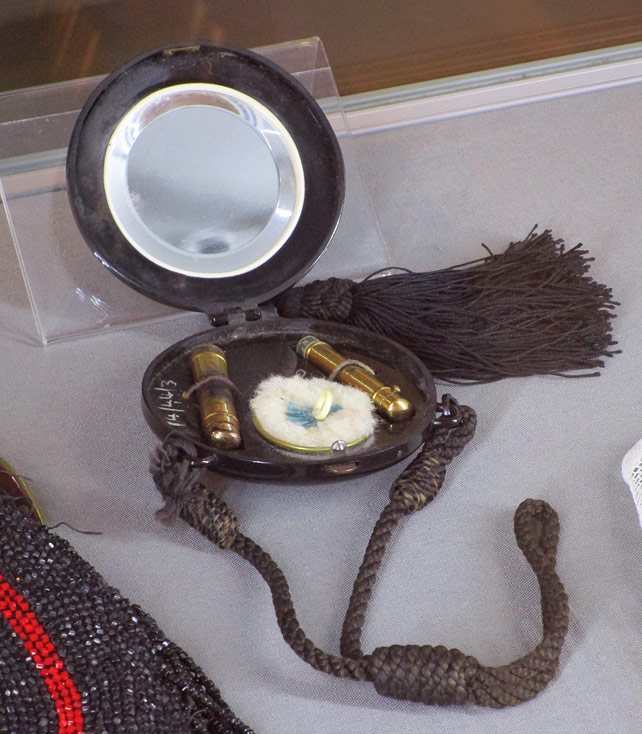
This dainty 1920s bakelite compact was just adorable with two bullet shaped containers and a teeny tiny powder puff. I really wished I could’ve seen it closed too because I wonder whether there was any decoration on the outside.
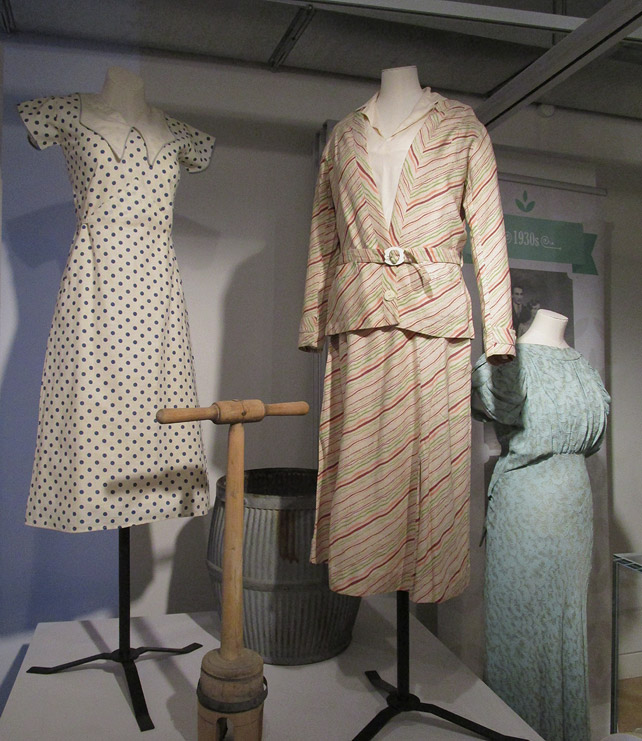
These 1930s dresses were my absolute favourites. I wanted them all! The striped linen suit in the middle was bought from Harrods in 1933 for 49 shillings and was part of special fashion line intended to be worn on a cruise and discarded afterwards. Thank goodness they didn’t!

The sleeve detail on this evening dress took my breath away. I leant over the cabinet in front of it to have a really good look because I couldn’t quite see where the arm hole was at first. The band that loops around the top edge creates a cut out look and then the beautiful swirl fabric drops from it in graceful drapes.
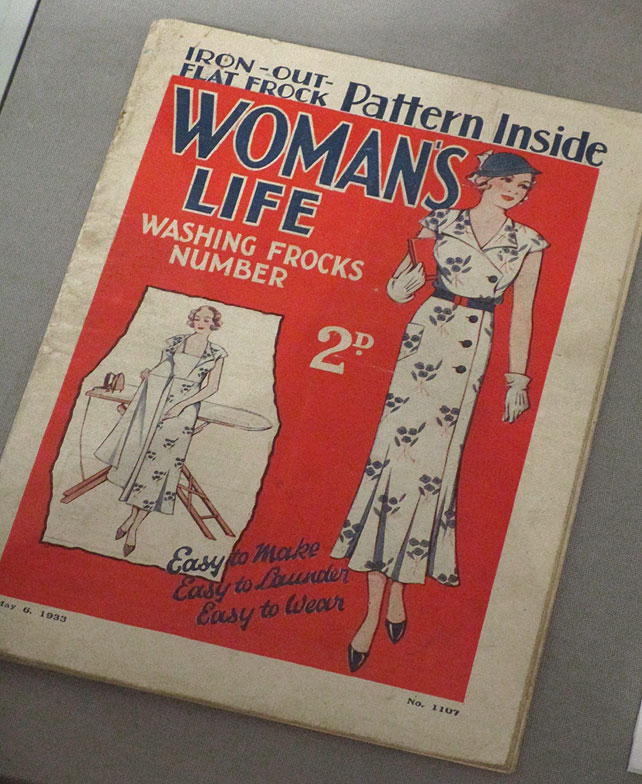
They were extremely lucky I didn’t break the glass of the cabinet with this pattern in it! This is exactly the style of dress I am obsessing over at the moment. It is so stylish and so chic and just so simple. I am going to have to try and draft my own pattern I think.
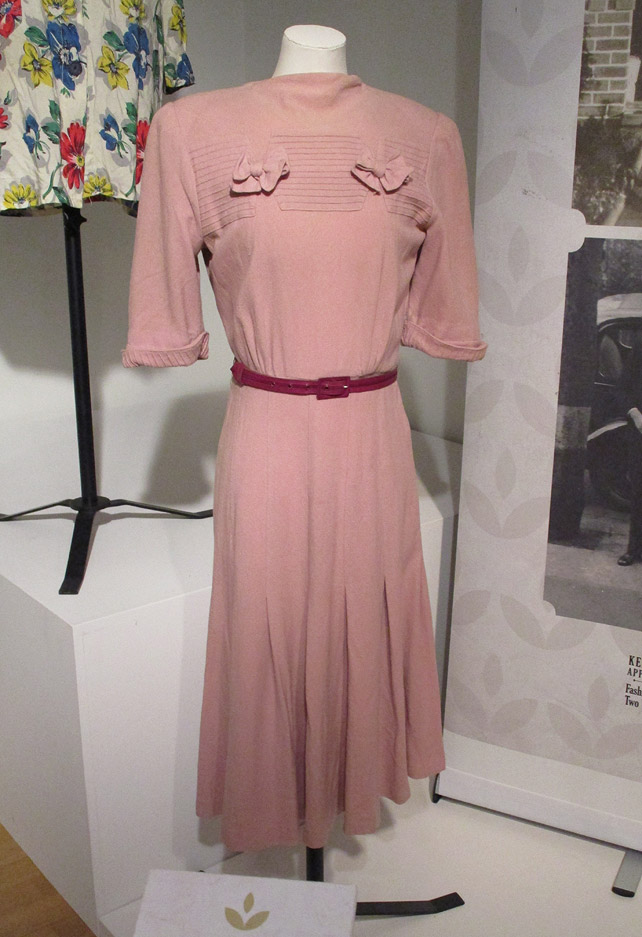
The forties section was great because it had examples of early WWII pieces, like this beautiful pink rayon dress, CC41 utility clothing and women’s uniforms. They had a vert smart navy blue ARP skirted suit which I took pictures of but the lighting wasn’t great so they didn’t come out terribly well.
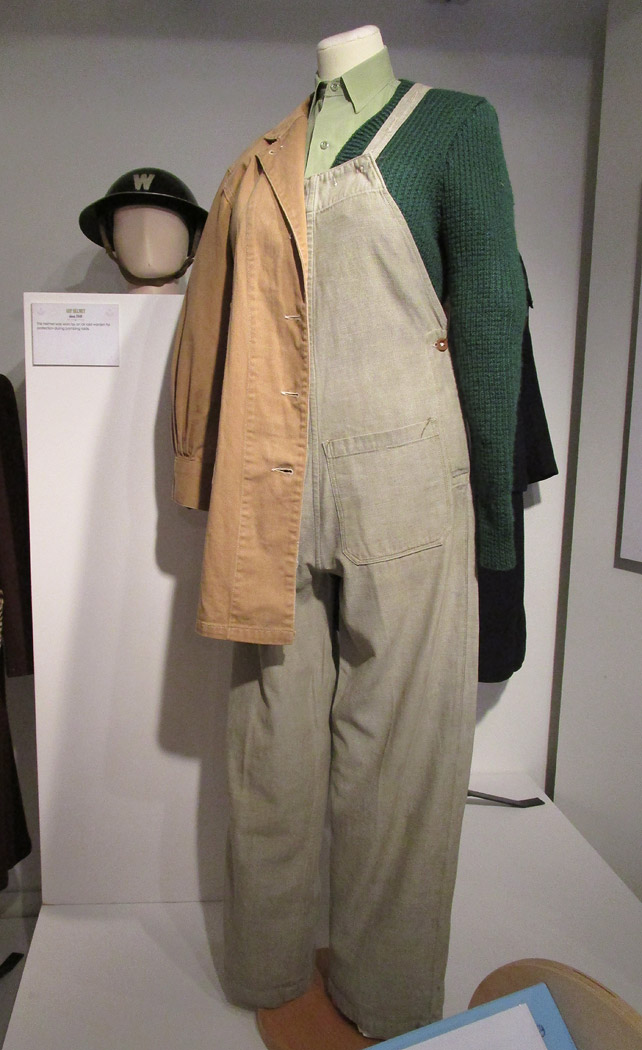
But thankfully this amazing Land Girl uniform did. In the lecture Julie Summers said that uniforms helped women to be empowered in their roles, that once they put them on they felt they had a place and were respected because of it. A lot of women also enjoyed the fact that if a piece of uniform became worn out it would immediately be replaced. In a time of austerity, when clothing was on a ration, this was a great way of getting new clothes.

In the cabinet next to the uniforms were several leaflets and books relating to the governments drive to help women take care of their appearances, such as this Make Do and Mend government issued book.
At the beginning of the war, the government enlisted the editor of British Vogue to help get the message out to women all across the country that it was their duty to be beautiful. They wanted to keep up morale and appear as a nation who would not be beaten down by the enemy and having its women look as stunning as possible, and not look down-trodden and worn out, they could help to achieve this.
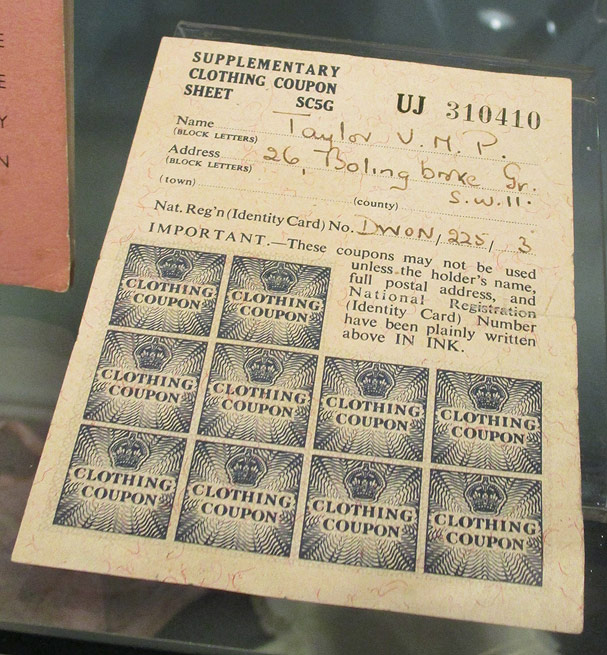
Of course, in reality it wasn’t that easy, especially when clothing became rationed and you would have to purchase everything from coats, hats and dresses down to underwear, gloves and shoes using clothing coupons.
The sale of silk stockings was halted in October of 1940 and all excess stock was exported to bring in extra money to the country. Therefore, until Nylons became a little easier to get hold of once the Americans arrived, women had to mend the ones they had or fake it with a pencil line running up the back of their legs.

The fifties section had this stunning two piece lingerie set of an overbust longline bra and panelled girdle. I thought it was a shame they couldn’t have found a bustier mannequin to put it on as this really didn’t show it off to its best potential.
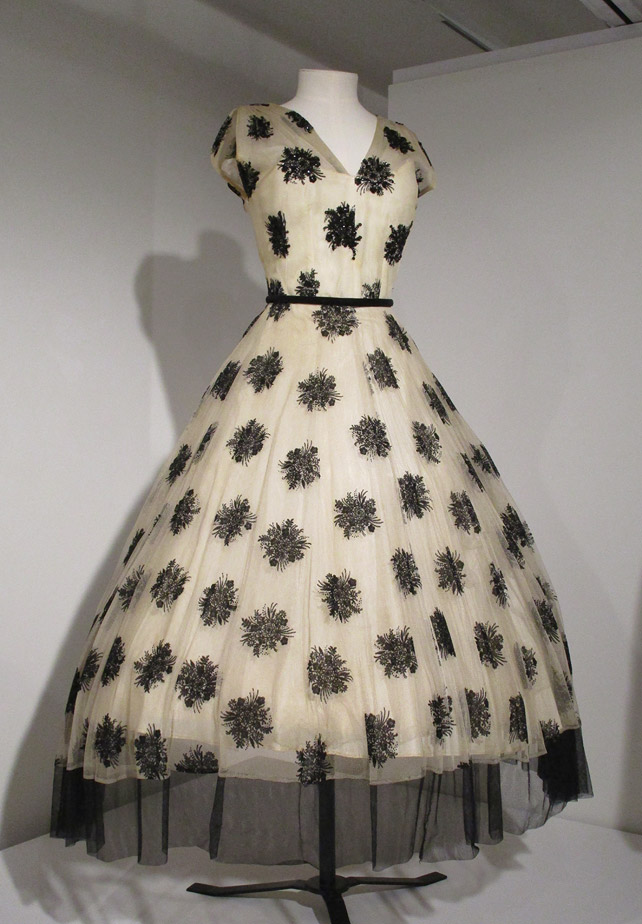
And then the pièce de résistance was this incredible multi-layered circle skirted dress. It shows the immense change from the austerity of the 1940s to the wealth and frivolities enjoyed just ten years later. I loved that they had this up on its own plinth as it really showed off its importance.
The exhibition was well worth going to see and I would highly recommend it if you are anywhere near Woodstock in Oxfordshire. However, it only runs until the 12th of April so you better be quick. And if you’re planning to go next Saturday (28th March) don’t forget to check out the Beachwear and Bikinis 1920 – 1960 talk in the afternoon.
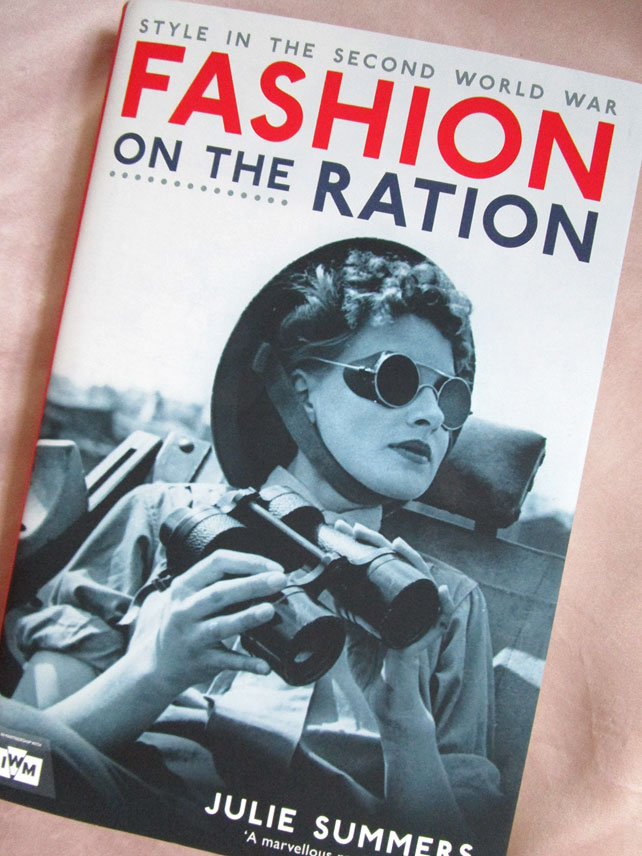
Next it was on to the lecture itself. It was a bizarre experience because not only was I the youngest person there (and I a’int that young!) but I was the only one dressed in vintage style. Everyone else, including one man on his own, was 50 or over and were obviously local due to the fact that everyone seemed to know each other. I sat on my own, in a row of chairs where no one else dared to come and sit. I felt like an alien who had invaded on their private event!
Nevertheless, it was a thoroughly enjoyable talk and Julie Summers kept everyone entertained with great stories and wonderful mind-boggling statistics. My favourite one was about the author Barbara Cartland who, during the time of rationing, bought up 150 wedding dresses and hired them out to brides-to-be so they could wear a traditional wedding dress instead of having of wear their ordinary clothes or uniforms. One wedding dress was worn 50 times by 50 different brides.
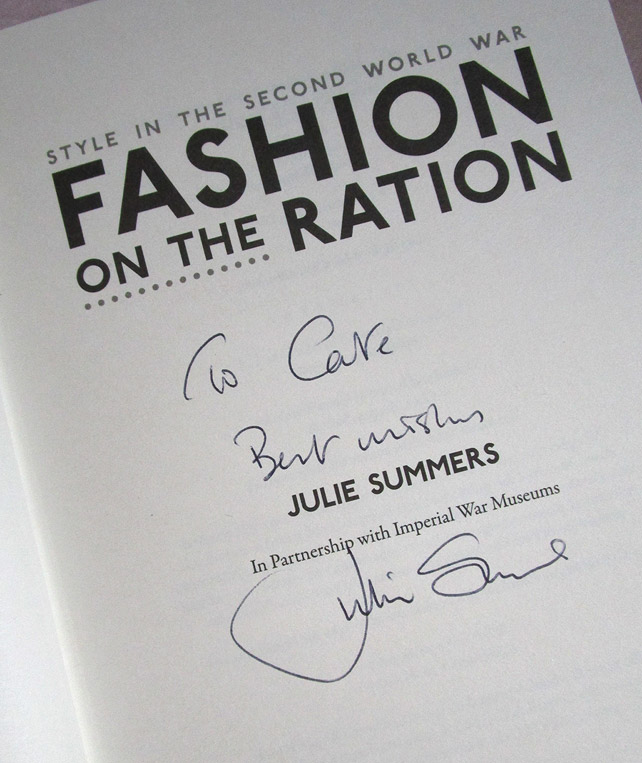
At the end Julie was selling copies of her Fashion on the Ration book and was signing them for everyone. I was so happy to get mine, particularly when she said she had spotted me in the audience and had loved that I’d made an effort. Then as I was leaving the guy who was on his own said “Beautiful outfit!” as I walked past. Oh, okay, it was worth dressing up just for that.
If you get a chance to catch one of Julie Summers lectures near you I’d highly recommend that you go. Just check your local museums and theatres as, I have to say, it wasn’t terribly well publicised. And in a month or so’s time look out for Home Fires on ITV, a six part drama about the life of Women’s Institute members on the Home Front which is based on her novel Jambusters.








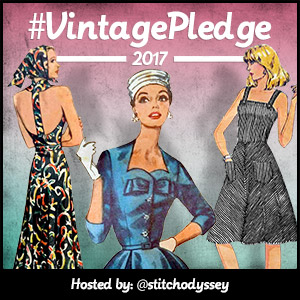
Annoyingly, the Julie Summers event in Bath is part of Bath In Fashion week, so by the time I realised it was going on, all the tickets had sold. Ersecakes. It sounds like a really good talk, and your local museum has some fab items on show. I love the fabric on that blue 1930s dress.
Oh no! That’s such a shame. It was a lovely afternoon and Julie really knew her stuff. I made loads of notes!! That dress was just stunning, if only I could’ve walked away with it.
What a wonderful exhibition! I absolutely am crazy for that 1930’s wrap dress sewing pattern – swoon. I shall have to have a look at this museum, I wasn’t previously aware of it.
Brilliant post as always my dear!
xxx
It’s a very small museum and I can’t imagine many people know about it but if ever take a trip to Blenheim palace then I would definitely recommend checking it out at the same time.